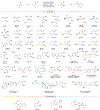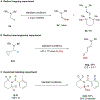General and Selective Metal-Free Radical α-C-H Borylation of Aliphatic Amines
- PMID: 36571075
- PMCID: PMC9784107
- DOI: 10.1016/j.chempr.2022.07.022
General and Selective Metal-Free Radical α-C-H Borylation of Aliphatic Amines
Abstract
Despite recent developments, selective C(sp3)-H borylation of feedstock amines remains a formidable challenge. Herein, we have developed a general, mild, and photoinduced transition metal- and strong base-free method for α-C(sp3)-H borylation of amines. This protocol features a regioselective 1,5-hydrogen atom transfer process to access key α-aminoalkyl radical intermediate using commercially available easy-to-install/remove iodobenzoyl radical translocating group. Remarkably, this general, efficient, and operationally simple method allows activation of primary and secondary α-C-H sites of a broad range of acyclic and cyclic amines toward highly regio- and diastereoselective synthesis of valuable α-aminoboronates. Utility of this protocol has been demonstrated by its employment in late-stage borylation of structurally complex amines and formal C-H arylation reaction of amines. Thus, it is expected that this operationally simple, general, and practical method will find broad application in organic synthesis and drug discovery.
Conflict of interest statement
DECLARATION OF INTERESTS The authors declare no competing interests.
Figures








References
-
- Matteson DS, Sadhu KM, and Lienhard GE (2002). R-1-acetamido-2-phenylethaneboronic acid. A specific transition-state analog for chymotrypsin. J. Am. Chem. Soc 103, 5241–5242. 10.1021/ja00407a051. - DOI
Grants and funding
LinkOut - more resources
Full Text Sources
